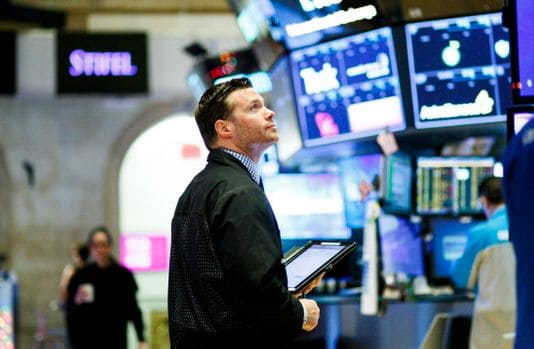
For stock investors, 2019 can’t get here fast enough.
One of the broadest measure of stocks, the Standard & Poor’s 500 index, has been pounded in 2018 by fears stirred up by trade disputes, rising interest rates and a slowing global economy — putting it on the precipice of a bear market and on track for its worst year since 2008 during the financial crisis.
While Wall Street pros expect 2019 to be another volatile year with plenty of challenges, they also expect stocks to mount a rebound after the market’s worst December performance since the Great Depression.
The average prediction is for a hefty gain of 25 percent in the S&P 500 next year, according to Bloomberg, citing year-end forecasts from stock pros at 19 Wall Street banks.
Millions of American have index funds or ETFs tied to the S&P 500, so its fate shapes how retirement and other savings accounts perform during the year.
The most bullish call is for a gain of almost 35 percent while the most pessimistic prognostication is for a positive, but less spectacular, return of around 14 percent.
A higher finish?
All of the strategists, whose average S&P 500 price target is 3,029, see the large-company U.S. stock gauge finishing 2019 higher than Friday’s close of 2,417.
The biggest bull currently is Binky Chadha, chief strategist at Deutsche Bank. His year-end price target for 2019 is 3,250, which he released Nov. 30 when the mood of the market was less pessimistic and stocks were trading 12 percent higher. His outlook reflects a gain of 34.5 percent from the close on Dec. 21.
Chadha now has the most optimistic outlook because Wall Street’s prior biggest bull, Jonathan Golub of Credit Suisse, recently pulled in his horns and slashed his prediction to 2,925 from an earlier Street-high of 3,350.
Given the market’s rapid decline this month, it’s quite possible other Wall Street strategists will dial back their outlooks for 2019 as well.
For now, though, the least optimistic market forecast comes from Morgan Stanley’s equity strategist Michael Wilson, who expects the S&P 500 to trade at 2,750 at year-end 2019, which translates to a gain of 13.8 percent from Dec. 21.
While there’s heightened risk of an economic slowdown next year due to uncertainties tied to the outcome of the trade dispute between the U.S. and China and the pace of interest rate hikes from the Federal Reserve, a recession is not expected by the stock strategists.
They’re more concerned about a slowdown in corporate earnings growth to single-digit percentage gains, compared with 2018, when profits grew more than 20 percent. Not only will profit growth be hurt due to tougher comparisons with 2018, they will also slow due to the fading benefits from President Donald Trump’s corporate tax cuts, a slowdown abroad in Europe and China, and the negative effects of higher borrowing costs.
The most bullish call
In his 2019 outlook, Deutsche Bank’s Chadha says the market has already absorbed a lot of bad news.
Stocks, he predicts, will eventually benefit from a pickup in earnings growth in the later part of 2019 that will result in solid profit gains of about 9 percent for the S&P 500. “Underlying growth,” he wrote, will be “relatively strong.”
Chadha is cognizant, however, that the market will recover slowly after the sharp spike in volatility in 2018. “It will take a while for the market to regain its prior peak,” Chadha wrote in his U.S. equities outlook piece in late November, prior to this month’s market meltdown. “Volatility shocks last awhile.”
There are a few factors that will help lift stock prices in the new year, Chadha noted in his report.
Just like 2018, the bulk of the buying demand will come from corporations themselves, Chadha predicts. He sees another year of strong corporate buybacks.
Citing an inflation rate that is unlikely to stay above the key 2 percent level for very long, Chadha also downplays the risk of the Fed making a policy mistake. “We see it as very unlikely that the Fed will become aggressive in raising rates any time soon to slow the economy,” he noted.
The size of the recent market decline, he adds, “suggests the market is pricing in a significant probability of a recession.” But leading economic indicators, which often signal a contraction is coming, have “shown no signs of turning yet.”
The most bearish call
Morgan Stanley’s Wilson, one of the earliest Wall Street pros to warn of brewing troubles in the stock market – which he dubbed a “rolling bear market” – expects the market to be held back in the new year by “disappointing” earnings, according to his “2019 U.S. Equities Outlook” published on Nov. 26.
While Wilson thinks the stock market remains in a long-term bull despite its recent drubbing, he says 2019 “will look a lot like 2018.”
Investors, he wrote, should brace themselves for another year of wild swings. He says he “wouldn’t be surprised” if the S&P 500 trades in a wide range, from 2,400 at the low end to 3,000 on the high end. Under those scenarios, stocks could be down 1 percent from current levels or up by as much as 24 percent.
Investors should expect “a choppy ride.”
The good news is that the stock market is far less expensive on a valuation basis than it was at the start of this year, which suggests the bulk of the price damage has already occurred, according to Wilson. That’s because of the two 10 percent-plus drops, or corrections, in 2018. The market’s price-to-earnings ratio — which shows how much investors are willing to pay per dollar of profits — has fallen from its peak of 18.5 times earnings at the end of 2017 to a low of around 15 times at the end of October. That’s the biggest “valuation” decline the market has suffered since 2011, he says.
In contrast, 2019 will likely to be characterized by “disappointing growth” and P-Es that don’t move up or down too much, he predicts.
Slowing economic growth, he argues, will push down corporate profits. Wilson expects analysts to lower their earnings growth rate estimates for 2019. There is a “greater than 50 percent chance” that the S&P 500 could suffer a modest earnings recession – defined as two quarters of negative year-over-year growth, he adds.
“The final leg of this bear likely won’t come until numbers are reduced for 2019,” he says.
Wilson also reminds investors that they need to be patient, noting that the market doesn’t rebound quickly after it “goes through such a dramatic shock,” as it has late in 2018.
“It typically takes months, if not quarters, to stabilize,” he says.
























